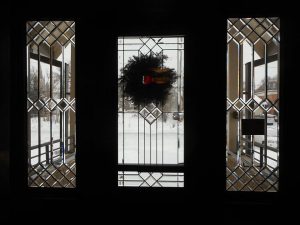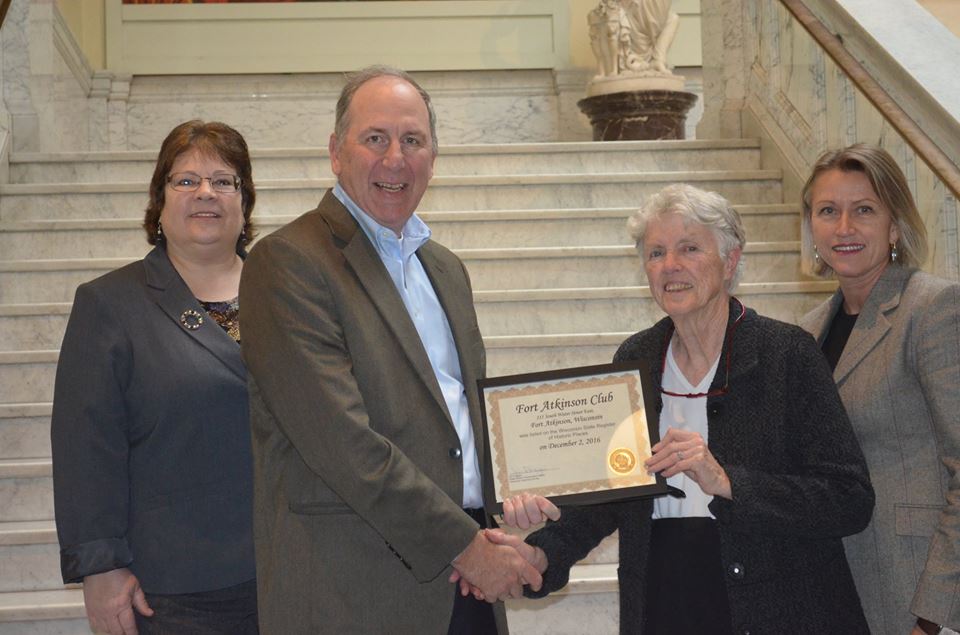This article appeared in The Daily Jefferson County Union on Tuesday, December 20, 2016 by Christine Spangler.
The Fort Atkinson Club reached a major milestone earlier this month when it was listed on the State Register of Historic Places.
The Wisconsin Historical Society placed the Fort Atkinson community center on its register Dec. 2.
The State Register is Wisconsin’s official list of state properties determined to be significant to Wisconsin’s heritage. The Division of Historic Preservation and Public History at the Wisconsin Historical Society administers both the State Register and National Register in Wisconsin.
“We are very excited to be on the State Register of Historic Places,” said Renae Mitchell, director of The Fort Atkinson Club, located at 211 S. Water St. East. “It was a several-year process.
“This honor truly rewards the vision of the Rock River Heritage Inc., as well as all the volunteers, community members and businesses that helped bring the historic building back to life,” Mitchell added.
She particularly thanked the Fort Atkinson Historical Society; Carol Cartwright, who wrote the application; Joan Jones, who spearheaded the restoration effort, and Rachel Nelan, Rock River Heritage Board of Directors president, “for the research and shepherding it through the application process.”
Mitchell said it is her understanding that the State Historical Society will forward the Fort Atkinson Club’s application to the National Register of Historic Places, and the club should know in four months or so whether it will be placed on that list.
 “It’s recognizing of the historic influence and importance of this building, as well as the high-quality restoration,” Mitchell said of the designation. “The (state) Review Board was just thrilled with the way the restoration had been done, and the fact that it was brought back to life and is now being used again.”
“It’s recognizing of the historic influence and importance of this building, as well as the high-quality restoration,” Mitchell said of the designation. “The (state) Review Board was just thrilled with the way the restoration had been done, and the fact that it was brought back to life and is now being used again.”
Built in 1912-13, the building overlooking the Rock River long was home to two important social organizations — the original Fort Atkinson Club and Billings Lodge 139, Free and Accepted Masons — reflecting the importance local social clubs and fraternal organizations played in the history of communities. Calling it “a fine example of the Craftsman style and one of the best examples in Fort Atkinson,” the Wisconsin State Historical Society lauded the renovation of this important landmark for being returned to public use for the benefit of the community.
The restored Fort Atkinson Club opened its doors for its first event on Jan. 24, 2015, after being purchased by Jones and then donated to the newly formed Rock River Heritage Inc., a nonprofit organization charged with returning the structure to its glory. Those glory days date back to March 29, 1912, when the Fort Atkinson Club was incorporated “to provide a businessmen’s clubhouse and home that shall be complete in all appointments.” The then-weekly Jefferson County Union reported, “The directors intend to push the building of the clubhouse with all possible speed.”
Designated as “purely social,” the club was paid for through 200 shares at $100 each. The local businessmen used it primarily as a men’s club, although women could visit on Wednesdays. According to an article in the Jefferson County Union dated May 31, 1912, the Fort Atkinson Club had 110 members at the time bids were being considered for the construction of the clubhouse. With members from nearly every trade, from cleaners and shop owners to lawyers and doctors, the Fort Atkinson Club met at W.D. Hoard & Sons Co. until the building was finished in 1913.
A peek at the membership roster read like a who’s who of Fort Atkinson. There were Arthur Hoard, publisher and owner of Hoard’s Creameries and, later, Bettersox Knitting Mills, on whose land the club was built; his brother, Frank Hoard, who was the first chairman of the Fort Atkinson Club, and his other brother, Halbert Hoard, and his father, William Dempster Hoard. Also among the members were David Curtis, Milo C. Jones, Oscar Cornish, Charles B. Rogers, A.J. Glover and W.F. Haumerson, among others.
Inspired by the Wisconsin Building at the 1904 World’s Fair in St. Louis, Mo., the club was designed by Milwaukee’s Charles Fitzgerald, one of four architects who bid on the project. It was built by J.O. Hughes & Son in 1912-13 for $10,376.35.
A housewarming party was held on Oct. 31, 1913, and the Jefferson County Union reported on Nov. 7 that it was “the most dazzling function ever given in Fort Atkinson.”
The article stated that “beautiful women and beautiful decorations were added to beauty in design and beauty of furnishings of the new Fort Atkinson Club last Friday night and together made a most brilliant scene, in fact, one never before equaled in this city. It was a crowning glory that will be in the memory of all club members ‘til earthly things pass from view.”
Greeting attendees at the “big front entrance” were Dr. W.H. Weld, Judge Charles B. Rogers, N.M. Hopkins and A.L. Stengel.
“Hats and coats were placed in spacious lockers in the hallway, while the ladies were given possession of the entire second floor. In the main lounging room and elsewhere, groups of ladies and gentlemen dallied until the banquet was ready and then went below,” the newspaper reported.
The grand opening ball drew around 200 guests, who enjoyed a five-course dinner and music by The Imperial, an orchestra from Madison.
The newspaper reporter gushed about the steward, Fred Barnes, “whose ability as a chef was far famed before he entered the portals of the Fort Atkinson Club.” It added that “exquisite music ran the gamut from Chopin and Verdi to the tango and lulled the senses or inspired small talk as the meal progressed.”
The Union reported that tables were set over the entire ballroom floor and bowling alley in the lower level of the building.
“Festoons of colored paper and Mother Goose designs had changed the place into a fairy grotto. At each plate was a delicate rose and a papier maché mammalian favor containing nuts. The waitresses were some of the most beautiful young ladies of the city and these remained and added brilliancy to the ball,” according to the Union.
The article stated that while the tables were being cleared, the gentlemen smoked and the ladies “satisfied their curiosity” while waiting for the ball.
“The floor after the wax worked in was as good as any floor, but few thought of the floor,” the reporter wrote of the floating dance floor. “On every side were beautiful gowns and exquisite arms and shoulders moving to music. It gave one an artistic elevation of the soul. It was a symphony for both eyes and ear. Occasionally, the lights dimmed and brought into prominence a weird sky with Mother Goose and two felines in silhouette, lit up by colored lamps — as stars.”
Meanwhile, upstairs in the main lounge, card-playing and socializing were under way.
“Great credit is due Capt. R.J. Parks and his able lieutenants, Fred Dieckhoff and Arthur Hrobsky, for the success of the housewarming party. There are more parties to follow,” the article concluded.
Indeed, there were more parties to follow, not to mention many discussions in front of the brick fireplace by cigar-smoking members and other gatherings.
And there was bowling … Two lanes in the lower level that were opened in 1915.
Club rules allowed the building to be open from 9 a.m. to midnight daily, with no members allowed to bring no more than one guest at a time. Wagering and soliciting were not allowed.
Old menus detail items sold such as wines, liquors, mixed drinks, salads, beer, cigars and sandwiches. The annual dues were $18. “This club is for the social enjoyment and play, if you please, of a lot of very intensely worked, young men,” the Jefferson County Union wrote. “They are not partial to the saloon as a meeting place for social converse. In one corner, we see a few cronies enjoying their rubber whist, whilst in another corner, a cue artist explaining the wonderful game he played at Pinger’s some five years ago. Down the stairs, we see the brawny arm sweep back, shoot forward with a slow, sure swing and lo, we hear a cry “strike” as the ball drops all the pins.”
The Fort Atkinson Club owned the building through Prohibition and into the Great Depression. Some of the chairs the club left behind remain in the building and might be nearly 100 years old.
It was in 1931 that the Fort Atkinson Club sold the building to the Masons for about $2,500 less than the members wanted.
Formed in 1862, the Fort Atkinson Masons had met in a variety of venues, most recently Petit Hall over the Wigdale Building, when they acquired the Fort Atkinson Club.
“Brother Paul Case, master during 1927, started a movement to accumulate a building fund for the lodge,” according to a history of Billings Lodge 129, F&AM, written for the organization’s 75th year in 1938. “This was just getting started when Brother Ben Walker, worshipful master, electrified the members with the news that the lodge had been offered the beautiful building and contents of the Fort Atkinson Club, standing on the bank of the river, and at a very low figure, as the club wished only to pass out of existence free of debt.”
The history noted that many Masons were Fort Atkinson Club members and owned stock in the structure.
On Jan. 7, 1930, the Masons voted that the trustees be empowered to subscribe $2,000 to complete the $30,000 necessary to close the deal for the clubhouse. “Nearly all of it was turned over to the lodge, a campaign for funds was put under way, and the property bought,” the Masons’ booklet reads. “It was then mortgaged for $15,000 and the mortgaged bonds sold for the money required to remodel it into the splendid temple we now own, among other things turning an unfinished attic into the handsome lodge room so suitable in size to all our Masonic activities.”
The Masons received the deed and abstract on Jan. 20 and they were moved in by Oct. 2, 1931, when they held a “special” at which the worshipful master welcomed members to their new home.
“Mention was made of gifts toward furnishing the rooms. The clock in the lower hall, picture of George Washington in the Tyler Room, electric clock in the lodge room, Bible on the altar, lighten emblems in the east wall, officer jewels and many others,” the lodge’s history noted. Among the lodge provisions was that there be no smoking in the lodge room, anteroom or restrooms on the third floor, “and one of the brethren stated that it would mean the downfall of the lodge.”
But it did not. The Masons dedicated their new temple Nov. 24, 1931, with Most Worshipful Grand Master W.R. Graves and members of the Grand Lodge, including Fort Atkinson’s own Joseph Morris acting as grand chaplain; Franklin Sweet, worshipful master, and Past Master Ben Walker as architect.
“The day ended with a banquet attended by many Masons from this and neighboring towns,” the history reads.
Meanwhile, a new fund had been started — from member pledges given in five annual installments — with interest on the unpaid balance. However, the nation was entering into a deep Depression.
“The well-known, but not highly thought of, Depression came on at this time and many did not pay on the principal or keep up the interest,” according to the history. “The building was neglected that interest on the bonds might be met, and but few bonds could be retired.”
About a dozen years later, the Masons decided they should get out of debt, so a committee was formed to take on this challenge. Members included Ben Zaffke, Herbert Wagenknecht, Sheldon Vance, Harvey Asmus and Fred Hadinger. They raised the necessary funds and the Masons burned their $11,000 mortgage Jan. 24, 1948, during the lodge’s 85th anniversary program and dinner served by members of the Eastern Star.
Through the ensuing decades, the Masons made updates to the building. In the 1970s during the nation’s energy crisis, it covered the exterior stucco with siding, including many of the more than 100 original windows.
The Billings Lodge eventually joined with Jefferson’s Masonic lodge and, in 1990, it sold the building to local developer Doug Erdman. It sat empty until Jones acquired it in 2011 for Rock River Heritage.
The organization undertook a multiyear, $2.3 million project paid for by donations and a $750,000 grant from the Fort Atkinson Community Foundation, with the Fort Atkinson Club opening its doors in January 2015. Dimension IV of Madison was the lead architect, Cold Spring Design and Bungalow Pros were consultants and Maas Brothers Construction Co. of Watertown was the construction manager.
The building encompasses about 6,000 square feet of occupied space. It has three floors, a solarium, two kitchens, a dumbwaiter, hardwood floors, a gas fireplace and two regulation bowling lanes. The lower level has a floating dance floor, and what used to be the Masonic ceremonial room on the second floor sports a barrel-vault ceiling and cove lighting.
Modern technology was added to the building, including two 80-inch television monitors that can be connected to laptop computers, microphones and a speaker system throughout the lower level and theater area, and a large projector and screen in the theater.
Today, the Fort Atkinson Club is a community center with programs such as spring and fall lecture series, wellness classes, youth programming and member hours, as well as a venue for weddings, business meetings and private parties. It is home to the Fort Atkinson Rotary Club’s weekly meetings.
A member appreciation reception is slated for Sunday, Jan. 29. Plans for 2017 include public dance gatherings and more.
Membership and donation forms are available at the club or online at www.fortatkinsonclub.org. Checks may be made payable to the FAC and sent or dropped off at: The Fort Atkinson Club, 211 S. Water St. East, Fort Atkinson, WI, 53538.
For more information about the Fort Atkinson Club, call (920) 568-1720 or email info@fortatkinsonclub.org.
The club also has a Facebook page.

